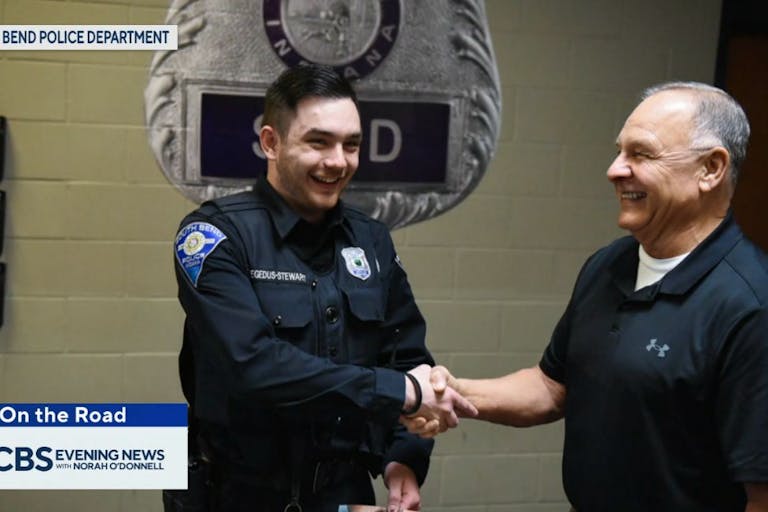
DOJ reverses Biden-era rule that allowed VA to commit abortions
Nancy Flanders
·
Human Rights·By Nancy Flanders
Full Circle: Officer reunites with abandoned baby he helped 25 years ago
A retired police lieutenant reunited with the abandoned baby boy he helped more than two decades ago — and that baby boy has grown up to become a police officer himself.
CBS shared the emotional story about ‘Baby Boy Doe’ and his reunion with retired South Bend Police Lieutenant Gene Eyster just months after Eyster’s only son unexpectedly died.
A baby boy who was abandoned in a the hallway of an apartment complex was helped by a police officer, and today is a police officer himself.
The two officers reunited, and this came at a time when the older officer had suffered the loss of a son — making the reunion even more meaningful for him.
Baby Safe Haven laws exist in every state to offer desperate parents an option to anonymously and safely surrender that child up to a certain time period after birth; that child can then be placed with an adoptive family. Adoption laws differ by state.
Twenty-five years ago, Lieutenant Eyster received a call that changed his life. “That was one of the strangest calls I think I’ve ever had: ‘We have found a baby in a box,'” he told CBS News. “You always wonder what happened.”
It was just days before Christmas on December 22, 2000, when a newborn baby boy was found abandoned in a common hallway of an apartment complex in South Bend, Indiana. He was swaddled in blankets inside a cardboard box, and Eyster brought him to the hospital.
Later, Eyster said he returned to the hospital “with a teddy bear” to “let everyone that walked past know that he was cared about.”
As time went on, Eyster wondered what had become of Baby Boy Doe, who had been adopted; the records were sealed.
Then, in April 2024, Eyster received another call — this time from a fellow officer who asked him if he remembered that baby. Of course, Eyster remembered him.
“And [the officer] said, ‘He’s sitting next to me. He’s my rookie,'” Eyster told CBS.
Article continues below
Dear Reader,
In 2026, Live Action is heading straight where the battle is fiercest: college campuses.
We have a bold initiative to establish 100 Live Action campus chapters within the next year, and your partnership will make it a success!
Your support today will help train and equip young leaders, bring Live Action’s educational content into academic environments, host on-campus events and debates, and empower students to challenge the pro-abortion status quo with truth and compassion.
Invest in pro-life grassroots outreach and cultural formation with your DOUBLED year-end gift!
The baby boy, Matthew Hegedus-Stewart, grew up knowing that he was adopted and had been left in a box, but didn’t know who had helped him until he joined the police department. Now he wears the same uniform that Eyster did and patrols the same neighborhood where the apartment complex — where Eyster found him — is located.
“Full circle moment,” said Hegedus-Stewart. “That hit home. I can only imagine from his point of view.”
Eyster believes it was divine intervention that brought them together, especially since their reunion came just months after Eyster’s only son, Nick, died unexpectedly at age 36.
“So the timing couldn’t have been any better; it helped to fill a void that I’ve had to deal with,” he said.
The abortion industry believes that babies like Matthew, who are at risk of being abandoned at birth or are labeled “unwanted,” should be aborted. Matthew’s story proves that even when parents are unable to care for a child, there are others who are willing to step in and help.
Baby Safe Haven laws, the first of which was created in 1999, exist to ensure that babies whose parents are unable to care for them are not abandoned like Matthew was. These laws allow parents to drop their babies off at specific safe locations, such as fire stations and hospitals, anonymously and without facing any repercussions, ensuring the baby is safe.
Other states have installed Safe Haven Baby Boxes to provide even more anonymity for parents surrendering infants.
Recently, abortion advocates have begun attacking safe haven laws, claiming they are “never a sincere effort” to help women and that “hardly anyone uses” them — false arguments that callously downplay efforts to help parents and infants facing desperate situations, and which devalue every single human life.
According to the National Safe Haven Alliance website, the total number of infants surrendered nationwide is estimated at nearly 5,000 since 1999 — an average of around 200 every year.
Live Action News is pro-life news and commentary from a pro-life perspective.
Contact editor@liveaction.org for questions, corrections, or if you are seeking permission to reprint any Live Action News content.
Guest Articles: To submit a guest article to Live Action News, email editor@liveaction.org with an attached Word document of 800-1000 words. Please also attach any photos relevant to your submission if applicable. If your submission is accepted for publication, you will be notified within three weeks. Guest articles are not compensated (see our Open License Agreement). Thank you for your interest in Live Action News!

Nancy Flanders
·
Human Rights
Angeline Tan
·
Human Rights
Bridget Sielicki
·
Human Rights
Carole Novielli
·
International
Angeline Tan
·
Human Rights
Nancy Flanders
·
Politics
Nancy Flanders
·
Human Interest
Nancy Flanders
·
Human Interest
Nancy Flanders
·
Analysis
Nancy Flanders
·
Politics
Nancy Flanders
·